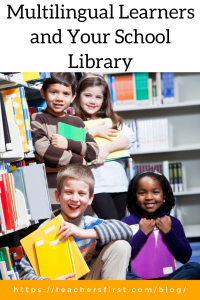School libraries play a pivotal role in enhancing multilingual learning experiences by providing resources and support to ensure that all students, regardless of their language background, have equal opportunities to learn and thrive.
There are many effective strategies for leveraging school library resources to support multilingual learners, but a diverse library collection is the first and best way. School libraries should stock books in the various languages spoken by the student population, including dual language books (which are written in both English and another language) and books about different cultures. These books not only provide a bridge for your English language learners but also give your English-speaking students windows into different cultures and perspectives. Most school library vendors today stock books in languages other than English and dual-language books. Hi-Lo (high interest age, low reading age) books are another bridge for multilingual students, as they help students read independently while learning English. School libraries can serve as language learning hubs by providing bilingual dictionaries and language learning resources. Librarians can also collaborate with language teachers to develop tailored learning materials and recommend supplementary resources based on students’ proficiency levels and interests.
In addition to traditional print materials, school libraries can offer digital resources and e-books accessible on tablets, computers, or other electronic devices. Digital platforms often provide a wider selection of multilingual materials and interactive features that engage students in language learning activities. Subscribing to digital libraries or online databases with multilingual content and/or embedded supports (World Book, for example) expands access to diverse resources beyond the physical constraints of the library space. Providing audio books online or accompanying the print book gives multilingual learners the ability to hear and see language at the same time.
Organizing multicultural library programs and events encourages cultural exchange and celebrates diversity within the school community. Libraries can host author visits, storytelling sessions, or book clubs focused on works by multilingual authors or works featuring diverse protagonists. These initiatives foster a sense of belonging among multilingual learners and promote cross-cultural understanding among all students. Collaboration between school librarians at the district level, educators, parents, and community organizations like your local public library is crucial for maximizing the impact of library resources on multilingual learners. Engaging parents and community members in library activities fosters a supportive network that reinforces language learning both inside and outside of school.
Engaging multilingual learners in your school library is a win for all students. As always, check out TeachersFirst resources and blog posts for more great ideas for English language learners. Everyone is welcome at the school library! ¡Todos son bienvenidos en la biblioteca escolar! Tout le monde est le bienvenu à la bibliothèque scolaire ! 欢迎大家来学校图书馆! الجميع مرحب به في مكتبة المدرسة! स्कूल पुस्तकालय में सभी का स्वागत है! Todos são bem-vindos na biblioteca da escola!


